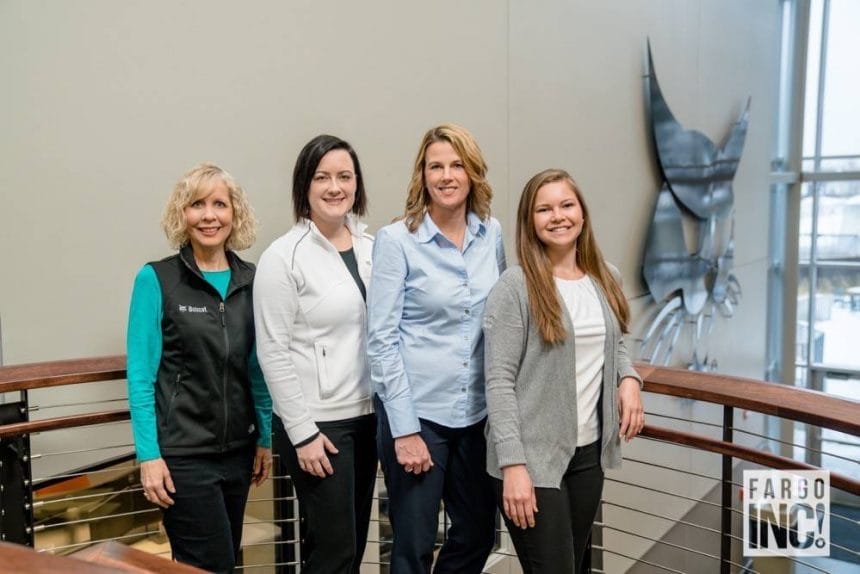Photo by Hillary Ehlen
Featured photo: (From left to right) Janna Diggs (Talent Acquisition Specialist), Amanda Johanneck (Talent Acquisition Manager), Tina Amerman (Director of HR and Talent Acquisition) and Samantha Leingang (University Relationship Representative)
With an unemployment rate of less than two percent in Fargo-Moorhead, we’re all fighting for the same employees. Between the tedious job postings, the screening of applicants, interviews and finally onboarding employees, filling a position is an expensive and time-consuming task. In fact, according to the U.C. Berkeley Institute for Research on Labor and Employment, it costs about $4,000, beyond salary and wages, to hire a new staff member. Well, Amanda Johanneck, Talent Acquisition Manager, and Tina Amerman, Director of HR and Talent Acquisition, for Bobcat Doosan have some helpful tips for the next time you’re hiring.
1. Everyone is a recruiter
Hiring isn’t only up to the Human Resources department and/or the hiring manager. Employees are your best source of candidates. Teach them how to use their networks and help you source candidates. Amanda: “This is something we work hard on in our organization. When working with our managers, we make sure it’s not just HR that recruits for a position. Fargo-Moorhead is a big small town, so we tell our managers “when you’re networking with others and going to different events around the area, you’re always recruiting as an ambassador for the company.”
TIPS
Maximize your reach on social media by getting your employees to help. Promote managers activity on LinkedIn, provide them with professional photo headshots and encourage them to share job opportunities.
A lot of your employees are probably part of professional organizations. Have them reach out to their network. For example, if you’re looking for an accountant, talk to the other accountants in your company who are part of the North Dakota CPA society and have them request to post positions within their membership group or ask for referrals.
An employee referral program is a great way to get employees to help with recruiting. This can take the form of a bonus, or even a free lunch, if an employee refers a candidate who accepts an offer.
2. Intake meetings. Do them. Every time.
Amanda: “In our intake meetings, prior to any recruiting or posting of positions, we sit down with the hiring managers and get really, really clear about what the requirements for the role will look like. It’s making sure the HR person knows as much about the position as possible and for the hiring manager it’s an opportunity to flesh out and explain the position in layman’s terms. This helps the recruiter to select and source a candidate that meets those requirements.”
TIPS
At these meetings, the hiring manager should also be thinking about their onboarding plan. They should start looking at what their training looks like and think about what they’ll do the first 90 days to one year on the job in terms of employee onboarding and assimilation process to ensure high retention and a positive employee experience.
3. Really think about your position postings.
Make sure requirements and preferred qualifications are strictly mapped out. You also want to think about the position title so it’s easy for candidates to find when searching under key words.
Tina: “It’s a different world recruiting now than in years past. Even for a company that has a well-known and global brand, we have to be more proactive than reactive and sell people versus them coming to us. You have to get creative when looking for those high-quality, passive candidates with specialized skills who aren’t actively in the job search market.”
TIPS
With search engine optimization, a job title is critical in a job posting. This dictates what people search and what they can find. If your company has unique titles internally but externally means nothing to the candidates, it may impact your applicant pool or searching capabilities.
Applicant tracking software is extremely helpful when posting a position. There are many different systems out there designed for this purpose. If you search Capterra.com, a site that ranks software, there are more than 350 different applicant tracking software systems. Sign up for some free demos and play around with a couple to see what works best for you.
4. Have a social media presence.
Social media is a great way for employees to find you. Indeed is a great (and free!) site to get your positions out to the public.
Amanda: “Social media presence is a really big thing. Any way that you can get your brand out there, the better. That does not mean you need to spend a lot of money connecting with people online. It does not mean you need to put a big campaign together. The process can be as easy as setting up a couple of free accounts and letting the community know what you’re up to.”
About Johanneck And Amerman
Amanda Johanneck has worked at Bobcat Doosan for eight years while Tina Amerman has worked at Bobcat Doosan for 14 years. Last year, the company recruited for over 1,000 positions.
5. Talk about company culture.
You need to show what you can offer your candidates. Really sell your company’s culture and benefits. Having some sort of community involvement will make it an easier sell bringing people onboard.
Tina: “It’s not just the positions you should be showcasing on social media. Understand what your employee value proposition is and provide a glimpse of this online to ensure it aligns with their values.”
Amanda: “The more aligned and specific you can get on this, the better. If the candidate already knows what you’re like and you’re making it really clear what your organization is like right from the start of the interviewing process, the better the chance the candidate will be the right match for your organization and you’re the right match for that candidate.”
TIPS
A common benefit for employees that can go a long way in showing your corporation’s community involvement, and is relatively affordable, is volunteer time off. Consider giving employees time off to use for volunteering.
6. A positive candidate experience is a MUST.
Not getting back to candidates or waiting too long to reach out to them will leave a bad impression. Remember, when you’re interviewing a candidate, they are also interviewing you.
Amanda: “I guarantee that every single organization in FargoMoorhead could work on this. A good candidate experience is a must. The unemployment rate is just too low in our area to not be responsive and not be thinking of what the candidate is feeling.”
TIPS
With how small the FM area is, word travels fast, so if a candidate has a bad experience, they might spread the word to other potential employees, which hurts your future chances in hiring or even impact your bottom line.
7. Build a pipeline.
Keep up relationships/ maintain communication with previous top applicants. Silver medalists for other positions can sometimes be the perfect fit for a different position. Also, consider boomerang employees; employees who have left and may want to come back.
Tina: “We’ve seen an increase in boomerang employees. Meaning those who have left the company and come back to work for us. They bring back a fresh perspective, are cost effective from an onboarding perspective and their fit is not a guess.”
TIPS
Having the conversation with employees about when they’re retiring can be a touchy subject. Consider making it part of your annual reviews to discuss employee’s long-term goals. Encouraging employees to give a 60-90 day notice before their retirement is also a good plan. This will hopefully allow you to bring somebody onboard in time to train with the outgoing employee.
8. Consider your hiring mix.
Don’t forget about internal applicants. Encourage career advancement and developmental roles for your key employees.
Amanda: “It’s important to make sure you’re looking at your internal employees as well and to create advancement opportunities for them. One of the things we do when we post a position is open it first internally or simultaneously with the external posting. All internal candidates are considered first. A conversation is had with all internal applicants so that if they apply – even if they aren’t the right fit – there is a development conversation that happens with them about how they can be a stronger candidate the next time.”
9. Establish relationships with groups and businesses in our community.
It’s always a good idea to cultivate relationships with organizations like the Economic Workforce Development, Job Service or third-party recruiters/ agencies. Partnering with schools is also an easy way to get in front of some early up-and-coming talent.
Amanda: “Working with schools is the one strategy that we have done a really good job with. We partner with all the schools in the area and get our brand in front of those kids before they’re even thinking about graduating. It’s a perfect way for students to see and understand what it’s like to work in the real world. But, it’s also perfect for us because we get the chance to get help with certain projects that need extra attention, but don’t justify a full-time hire.”
TIPS
You can even work with professors on specific projects, so you don’t have to necessarily bring an intern on your payroll. Operation Intern is also an extremely helpful resource from the state. This program will reimburse, to a certain amount, select employers for internships. New recommendations for this program will be put forth in the 2019 legislative session, so watch operationintern.com for more information.
10. Focus more on workforce planning.
As an organization, consider forecasting your workforce needs. Discuss, as a leadership team, where your areas of growth are and the impact to your talent bench strength.
Tina: “Workforce planning is about developing a proactive approach to talent acquisition and identifying gaps in your workforce today and future needs to meet business objectives. Also consider metrics like retention, time to fill, projected retirements, etc.”
TIPS
It’s important to try and find that sweet spot when an employee is leaving their position and when you bring a new employee on. That way the employee leaving will have the opportunity to train the new employee.








